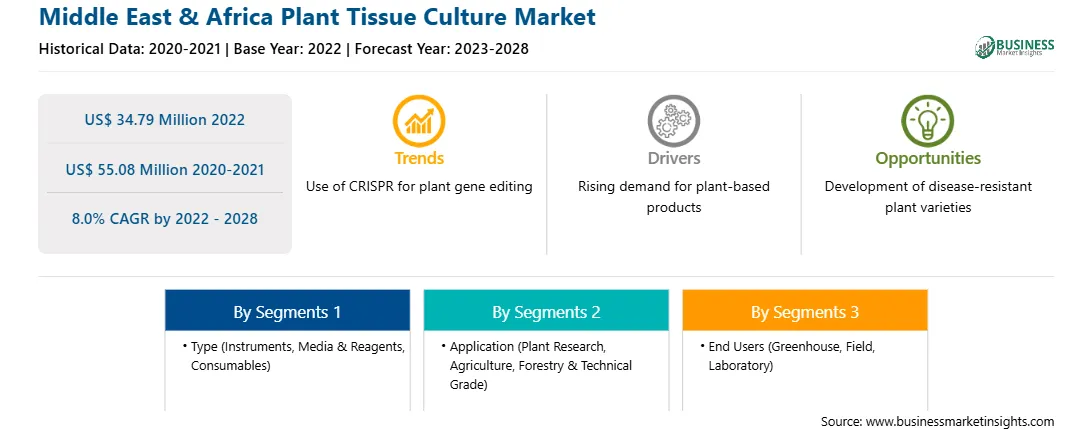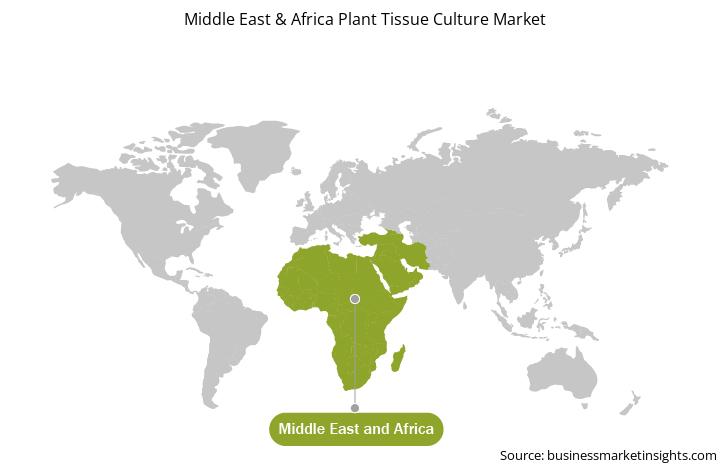中东和非洲植物组织培养市场预测至 2028 年 – COVID-19 影响和区域分析 – 按类型(仪器、培养基和试剂以及消耗品)、应用(植物研究、农业、林业和技术等级以及其他)和最终用户(温室、田间和实验室)
No. of Pages: 124 | Report Code: BMIRE00027946 | Category: Life Sciences
No. of Pages: 124 | Report Code: BMIRE00027946 | Category: Life Sciences
花卉栽培的激增支撑市场生长
花卉栽培是观赏园艺的一个分支,涉及花卉、观赏植物和插花的种植和营销。植物组织培养是根据群体的需要来培育花卉的。如今,鲜花被用作食物,因为它们含有营养保健品和感官特性。花冠的色素浓度通常很高(特别是类黄酮和类胡萝卜素),它们的进化是为了在颜色上吸引传粉者,表明其具有显着的营养活性,特别是在抗氧化能力方面。玫瑰、柑橘花、薰衣草、木槿和旱金莲等食用花卉在注重健康的消费者中越来越受欢迎。食用花卉提供生物活性物质,包括维生素A、C、核黄素、烟酸,以及钙、磷、铁和钾等矿物质,最终有益于消费者的健康。为了生产提供这些生物活性物质的花卉,需要使用基因工程和组织培养技术。花卉作为营养食品添加剂的需求不断增长,主要推动了植物组织培养市场的增长。
市场概况
中东和中东地区非洲植物组织培养市场分为沙特阿拉伯、阿联酋、南非以及中东和非洲其他地区。非洲。阿联酋、巴林、沙特阿拉伯、科威特、卡塔尔和阿曼人口的增长可能与农作物需求的增加有关。推动中东和中东地区的主要因素非洲植物组织培养市场包括国内和移民人口的增加、健康意识的增强、口味和偏好的变化以及可支配收入的增加,这些因素都鼓励将营养食品消费作为稳定饮食的一部分。
中东和中东地区非洲植物组织培养市场收入及预测至 2028 年(百万美元)
中东和中东地区非洲植物组织培养市场细分
中东和非洲非洲植物组织培养市场根据类型、应用、最终用户和国家进行细分。根据类型,中东和非洲非洲植物组织培养市场分为仪器、媒体和设备。试剂和耗材。仪器细分市场在2022年占据最大的市场份额。此外,仪器细分市场分为培养箱、离心机、显微镜、灭菌器等。同样,媒体和试剂分为murashige和skoog介质、linsmaier和skoog介质等。
根据应用、中东和非洲植物组织培养市场分为植物研究、农业、林业和农业。技术等级等。 农业细分市场在 2022 年占据最大的市场份额。
基于最终用户、中东和非洲地区;非洲植物组织培养市场分为温室、田间和实验室。 野外细分市场在 2022 年占据最大的市场份额。
按国家、中东和非洲地区划分。非洲植物组织培养市场分为沙特阿拉伯、南非、阿联酋以及中东和非洲其他地区。非洲。中东其他地区和2022 年,非洲将主导市场。
Thomas Scientific LLC;西格玛-奥德里奇有限责任公司; HiMedia 实验室私人有限公司;沉箱实验室公司;阿尔法实验室有限公司;贝克顿·迪金森公司;和 Al-Rajhi 组织培养实验室是在中东和非洲地区运营的领先公司。非洲植物组织培养市场。
Strategic insights for Middle East & Africa Plant Tissue Culture involve closely monitoring industry trends, consumer behaviours, and competitor actions to identify opportunities for growth. By leveraging data analytics, businesses can anticipate market shifts and make informed decisions that align with evolving customer needs. Understanding these dynamics helps companies adjust their strategies proactively, enhance customer engagement, and strengthen their competitive edge. Building strong relationships with stakeholders and staying agile in response to changes ensures long-term success in any market.

| Report Attribute | Details |
|---|---|
| Market size in 2022 | US$ 34.79 Million |
| Market Size by 2028 | US$ 55.08 Million |
| Global CAGR (2022 - 2028) | 8.0% |
| Historical Data | 2020-2021 |
| Forecast period | 2023-2028 |
| Segments Covered |
By 类型
|
| Regions and Countries Covered | 中东和非洲
|
| Market leaders and key company profiles |
The regional scope of Middle East & Africa Plant Tissue Culture refers to the geographical area in which a business operates and competes. Understanding regional nuances, such as local consumer preferences, economic conditions, and regulatory environments, is crucial for tailoring strategies to specific markets. Businesses can expand their reach by identifying underserved regions or adapting their offerings to meet regional demands. A clear regional focus allows for more effective resource allocation, targeted marketing, and better positioning against local competitors, ultimately driving growth in those specific areas.

The Middle East & Africa Plant Tissue Culture Market is valued at US$ 34.79 Million in 2022, it is projected to reach US$ 55.08 Million by 2028.
As per our report Middle East & Africa Plant Tissue Culture Market, the market size is valued at US$ 34.79 Million in 2022, projecting it to reach US$ 55.08 Million by 2028. This translates to a CAGR of approximately 8.0% during the forecast period.
The Middle East & Africa Plant Tissue Culture Market report typically cover these key segments-
The historic period, base year, and forecast period can vary slightly depending on the specific market research report. However, for the Middle East & Africa Plant Tissue Culture Market report:
The Middle East & Africa Plant Tissue Culture Market is populated by several key players, each contributing to its growth and innovation. Some of the major players include:
The Middle East & Africa Plant Tissue Culture Market report is valuable for diverse stakeholders, including:
Essentially, anyone involved in or considering involvement in the Middle East & Africa Plant Tissue Culture Market value chain can benefit from the information contained in a comprehensive market report.